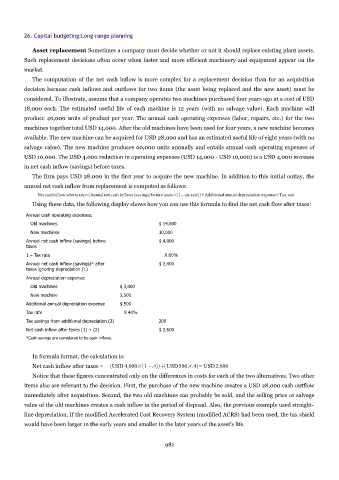Page 980 - Accounting Principles (A Business Perspective)
P. 980
26. Capital budgeting:Long-range planning
Asset replacement Sometimes a company must decide whether or not it should replace existing plant assets.
Such replacement decisions often occur when faster and more efficient machinery and equipment appear on the
market.
The computation of the net cash inflow is more complex for a replacement decision than for an acquisition
decision because cash inflows and outflows for two items (the asset being replaced and the new asset) must be
considered. To illustrate, assume that a company operates two machines purchased four years ago at a cost of USD
18,000 each. The estimated useful life of each machine is 12 years (with no salvage value). Each machine will
produce 40,000 units of product per year. The annual cash operating expenses (labor, repairs, etc.) for the two
machines together total USD 14,000. After the old machines have been used for four years, a new machine becomes
available. The new machine can be acquired for USD 28,000 and has an estimated useful life of eight years (with no
salvage value). The new machine produces 60,000 units annually and entails annual cash operating expenses of
USD 10,000. The USD 4,000 reduction in operating expenses (USD 14,000 - USD 10,000) is a USD 4,000 increase
in net cash inflow (savings) before taxes.
The firm pays USD 28,000 in the first year to acquire the new machine. In addition to this initial outlay, the
annual net cash inflow from replacement is computed as follows:
Net cashinflow after taxes=Annual net cash inflowssavings before taxes×1 – tax rateAdditionalannual depreciation expense×Tax rate
Using these data, the following display shows how you can use this formula to find the net cash flow after taxes:
Annual cash operating expenses:
Old machines $ 14,000
New machines 10,000
Annual net cash inflow (savings) before $ 4,000
taxes
1 – Tax rate X 60%
Annual net cash inflow (savings)* after $ 2,400
taxes ignoring depreciation (1)
Annual depreciation expense:
Old machines $ 3,000
New machine 3,500
Additional annual depreciation expense $ 500
Tax rate X 40%
Tax savings from additional depreciation (2) 200
Net cash inflow after taxes (1) + (2) $ 2,600
*Cash savings are considered to be cash inflows.
In formula format, the calculation is:
Net cash inflow after taxes = USD 4,000×1−.4USD500×.4=USD2,600
Notice that these figures concentrated only on the differences in costs for each of the two alternatives. Two other
items also are relevant to the decision. First, the purchase of the new machine creates a USD 28,000 cash outflow
immediately after acquisition. Second, the two old machines can probably be sold, and the selling price or salvage
value of the old machines creates a cash inflow in the period of disposal. Also, the previous example used straight-
line depreciation. If the modified Accelerated Cost Recovery System (modified ACRS) had been used, the tax shield
would have been larger in the early years and smaller in the later years of the asset's life.
981

